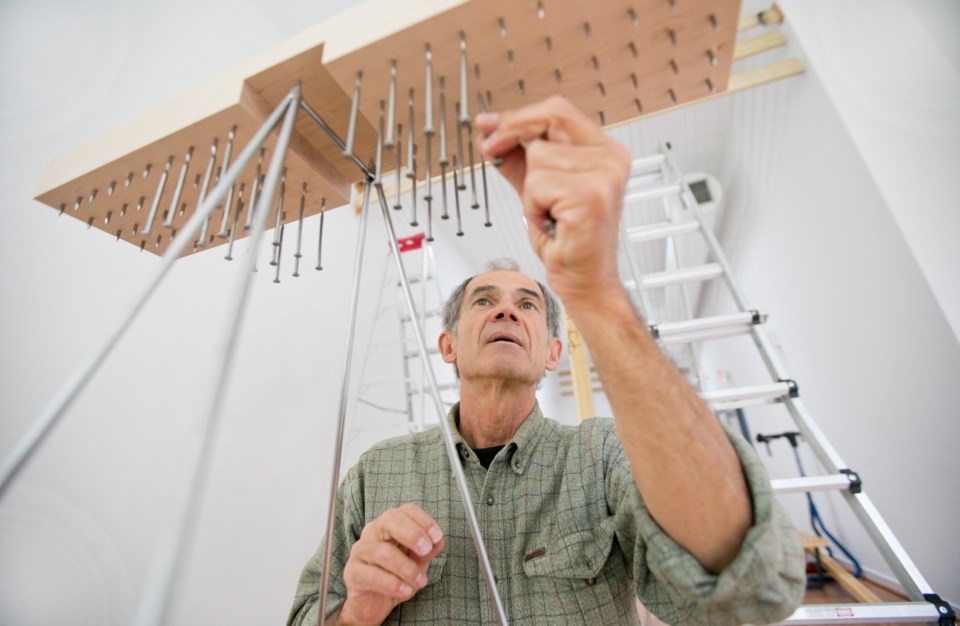What: Chris Lindsay’s Change
Where: Deluge Contemporary Art
When: Opening Friday at 7 p.m., runs to July 27.
Admission: Free
Plenty of people dream about leaping from one career path to another. But few have the cajones to do it like microbiologist-turned-artist Chris Lindsay.
After decades of scientific research, Lindsay, 62, presents his first solo art show since graduating from the University of Victoria’s master of fine arts program this spring. The show, at Deluge Contemporary Art, opens Friday.
In the narrow white gallery space, Lindsay’s latest work shifts space. Stainless-steel wires drape from the ceiling in soft waves, drawing attention to parts of the room that might otherwise go unnoticed, such as the skylight and vents.
On the floor sit four squares of colour constructed from layers of silk thread.
On one wall, a projected image taken by UVic’s Scanning Transmission Electron Holograph Microscope — dubbed “the world’s most powerful microscope” — shows enlarged atoms. They make geometric patterns that mirror Lindsay’s own creations, which tend to be precise and patterned.
The worlds of science and art, he says, have more in common than many people think.
“Science and art, I think, are part of the same expression,” Lindsay said in an interview at the gallery.
“We do art to generate a new experience, a new thought. … Through that, we learn about ourselves in this place and in relation to everything around us. And I think science is doing exactly the same thing.”
Change, as the exhibit is titled, is a fitting theme. On a personal level, Lindsay has gone through plenty of it.
Born in Nova Scotia to two teachers who moved around for work, he became accustomed to mobility at a young age. He kept the habit as an avid life-long learner, with four degrees between studies in Wolfville, N.S., Ottawa, Guelph, Ont., Saskatoon and finally, Victoria.
Art was something he dabbled in. But for a long time, he didn’t consider it a career option.
“I believed that if you couldn’t do a representational drawing, you couldn’t be an artist,” he said.
Ultimately, however, he switched gears after leaving an ill-fitting job developing biological fertilizers and pesticides in Saskatoon. While prestigious, he found his role had more to do with administration than the microbiology that he entered the field for.
He began taking art classes in Ottawa about eight years ago and hasn’t looked back.
“I met an old friend that I hadn’t seen for 15 years, told him what I was doing, and he said, ‘You always wanted to do that.’ So I guess I did, but it always kind of got put off. Life had its own trajectory.”
Related to his biology background, Lindsay brings some environmental activism to his work in the gallery: Challenging the viewer’s spatial perspective seems an imaginative move to make them aware of their place in the world.
Lindsay say that philosophically, he believes humans are getting further away from recognizing themselves as creatures on the planet, or the damage they’re doing.
“We’re aware of it intellectually,” he said. “But I think until we’re aware of it personally and imaginatively and it really goes into our psyche, nothing’s going to happen.”
But Lindsay says his background and intentions are irrelevant to the way he hopes viewers experience his installation and he’s reluctant to talk about his intentions.
“You don’t have to know anything about art, you don’t have to know anything about what I put into it. But if you can walk into the room and have an experience, that’s what I’m trying to achieve,” he said.
Rather than offering absolute answers, he says what’s more important is challenging the viewer with new questions.
“That’s what’s really human about all of this,” he said. “It’s not answering where we came from and why we’re here. It’s saying, we’re here and that’s absolutely amazing. I wonder why that is? And just going with that.”
